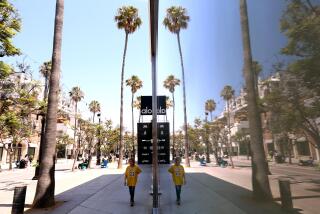Focus: Horton Plaza: from remarkable vision to troubled reality
SAN DIEGO — The late author Ray Bradbury imagined humans living on Mars, “firemen” on a mission to burn books — and a radical attempt to reshape downtown San Diego.
In his 1970s essay, “The Aesthetics of Lostness,” the Los Angeles science fiction writer extolled the joys of exploring safe yet stimulating urban streets.
“The premise behind the essay,” Bradbury reflected shortly before his death in 2012, “was building a city where people could spend an afternoon, getting safely lost, just wandering about. Jon Jerde built Horton Plaza in downtown San Diego using my essay as his touchstone.”
A landmark of urban design and a turning point in San Diego’s history, Horton Plaza opened in August 1985. This collaborative effort drew on the talents of Jerde, the architect; Ernest Hahn, the developer; a gaggle of city planners, politicians, activists and gadflies; and even Bradbury, the author of “Fahrenheit 451.”
Today, mired in a midlife crisis, Horton Plaza seems to have lost its sparkle. The mall is bleeding tenants: Nordstrom packed its Coach bags last year; Panda Inn, Horton Plaza’s last full-service restaurant, departs Jan. 31. Besides empty storefronts, visitors wandering the five-story, 900,000-square-foot complex see peeling paint, chipped tiles and cracked woodwork.
Westfield, Horton Plaza’s Australian owner, has promised a “future revitalization” of this property but has not released any details.
Malls around the world face daunting challenges, as online stores siphon off consumers. For busy shoppers, Horton Plaza presents an additional drawback: its trademark design of meandering walkways.
Horton Plaza 2.0: Beer hall, housing, ‘fashionable front door’? »
“I’m now retired — I have two hours to wander around and find out where the hell the escalator is,” said the Rev. Joe Carroll, a Horton Plaza regular when he ran Father Joe’s Villages, a local charity devoted to the homeless. “But there’s not a lot of people today who want to do this.”
If Horton Plaza is a faded beauty, it still has good bones and a certain charm.
“It would be a shame to lose a place like this,” said Andrew Flavell, a tourist from New Zealand, recently admiring the many shops that, even now, populate this mall. “Sometimes, when you’ve got something good, you don’t appreciate it.”
In long relationships, sometimes you lose sight of the qualities that captured your heart. You may forget this place’s impact on San Diego — and the world.
“Horton Plaza,” said Andrea Pavia, a consultant with Steer Davies Gleave, an urban design firm in Los Angeles, “was a game changer.”
Porn shops, peep shows
Four months before Horton Plaza’s grand opening, a real estate consultant named Greg S. Shannon assessed its prospects. He was not encouraging.
“The industry looks at it as the biggest risk in the country,” Shannon told a San Diego Evening Tribune reporter, Ann Perry. “There have been no major shopping centers on the scale of Horton Plaza in a downtown as small and neglected as San Diego. It’s a real major reversal.”
Since the 1950s, American shopping malls — like American residential developments — had been focused on the suburbs. Left behind were inner cities, including San Diego’s.
“Downtown was definitely a collection of porn shops and peep shows. There was no reason to come here,” said Sam Woodhouse, artistic director of the San Diego Repertory Theatre, part of Horton Plaza since 1986.
Even with a new attraction, could downtown entice suburban residents to drive past closer malls, then shop in an area surrounded by an entrenched homeless population? A critical question, as Horton Plaza’s success initially depended on its ability to woo shoppers from the suburbs.
“Back around then, there were only 13,000 people living downtown,” said Gary Smith, president of the Downtown San Diego Residents Group. “How on earth would downtown support a shopping center?”
Moreover, the construction of Horton Plaza coincided with a campaign to clean up the surrounding Gaslamp Quarter. When Art Skolnik was hired as the Gaslamp Quarter Council’s leader in 1984, the area was notorious for drug trafficking and prostitution.
“When people came through the Gaslamp,” Skolnik said, “they could be turned off and not ever want to come to Horton Plaza. Or the opposite could happen, we could improve enough that going to Horton Plaza through the Gaslamp would be a good thing.”
All these concerns eased the weeks before the grand opening. Planning a fundraiser at the site for Aug. 8, 1985, the night before Horton Plaza’s public debut, Hahn expected 5,000 guests.
Proceeds from the 5,000 tickets, priced at $50 each, were earmarked for four San Diego charities.
When all 5,000 sold, Hahn added another 1,000 tickets.
They sold out.
Hahn added 500 more. They sold, too. And then another 500. In the end, 7,000 tickets had been snapped up.
If the party was a success, the next day’s public unveiling was a spectacle, drawing an estimated 35,000. Philippe Petit, the French high-wire walker whose résumé included a stroll between the twin towers of Manhattan’s World Trade Center, dangled overhead. Champion kite flyers demonstrated their skills from the complex’s rooftops. The Cotton Club Dancers and a Dixieland band performed. Stilt walkers and mimes roamed the mall’s winding pathways.
The day’s speakers included U.S. Sen. Pete Wilson, who had advocated this project and the Gaslamp revival when he was San Diego’s mayor, and designer Jerde.
“We hope you like it,” Jerde said.
People did. In its first year, Horton Plaza drew 25 million visitors. This mall — and, with it, downtown San Diego — had arrived on the national map.
“This city has desperately needed a town square,” architecture critic Paul Goldberger wrote in The New York Times, “and now it has one.”
Lost in the garage
Jerde’s “wildly exuberant” design owed almost as much to Disneyland as Italian hill towns, Goldberger noted.
“It is best described as a conventional shopping mall on a stage set for an Italian hill town, a mix of turrets and colonnades and terraces and towers, all in tones of peach and apricot and rose and ochre,” the critic wrote.
“It is entered by a grand staircase, and its main walkway twists and turns to create constantly changing vistas.”
Horton Plaza quickly became a San Diego must-see, along with Balboa Park, the San Diego Zoo and SeaWorld. (It’s still a draw. On a recent morning, visitors included families from Mexico, Canada and New Zealand.) And it wasn’t just tourists flocking to the site.
“The first trolley line went in at the same time,” said Smith, leader of the Downtown San Diego Residents Group, “and huge numbers of people rode the trolley up to shop at Horton Plaza.”
Drivers who traveled to the mall discovered another of its quirks: the parking garage. There are two connected garages, actually, with levels associated with fruits or vegetables — 5 Tomato, say. Moreover, parking levels do not correspond to mall levels. Someone on the mall’s fifth level, for instance, needs to walk downstairs to reach the garage’s sixth floor.
Tales of departing shoppers who couldn’t find their cars are legendary.
“If you don’t look at what fruit level you are on,” Smith said, “you are toast.”
Skolnik agreed: “You’d have somebody running around, looking for a car and saying, ‘I parked on Avocado and I don’t remember if it’s a fruit or a vegetable!’”
Shopping for the back story of Horton Plaza »
And then there’s the hodgepodge of parking rates. Today, parking is free for one hour, and each succeeding 15 minutes is $2. Unless you enter after 8 p.m. and leave before 5 a.m., when the flat rate is $10. Unless it’s Thursday, Friday or Saturday, when the overnight flat rate is $20.
Plus, Horton Plaza veterans stretch their free parking to two hours with validation at the Jimbo’s grocery store, or three hours, with validation at the UA Horton Plaza 8 theaters or at the cosmetics department of Macy’s.
At suburban malls, parking is free. Being downtown, surrounded by parking lots that charge $10, $20 or more, Horton Plaza doesn’t have that option.
“People hate to come there and pay for parking to shop,” Smith said. “But if you do have free parking, you’d be packed solid in five minutes.”
The garage is an aesthetic problem, too. Along Horton Plaza’s southern boundary, there’s a complete lack of street-level shops, just level after level of parked cars.
Nonetheless, Horton Plaza’s backers say it did much to enliven downtown. Still does, insist the folks at the San Diego Repertory Theatre, which has produced about 200 shows in the mall’s Lyceum since 1986.
In the Rep’s last fiscal year, it drew about 100,000 people.
“We’ve demonstrated that it is safe to come downtown,” artistic director Woodhouse said, “and families would come downtown if you gave them a reason to get here.”
The eternal mall?
If Horton Plaza’s future as a retail center is uncertain, its position among urban planners seems secure. From MIT to Turkey’s Çankaya University, Jerde’s “experience architecture” is cited as a textbook example of how malls can revive sagging urban cores.
“Horton Plaza,” Turkish planner Buket Ergun Kocaili wrote in her 2010 master’s degree thesis, “redefined the urban retail experience and served as a catalyst for regeneration of the downtown.”
This catalyst also boosted Jerde’s career, whose work on Horton Plaza helped secure his position as the 1984 Los Angeles Olympics’ architect. He died in 2015 at the age of 75, leaving behind a long roster of landmark projects, from Hollywood’s Universal CityWalk (1993) to Tokyo’s Roppongi Hills (2002).
“They work at creating an urban experience — a private and controlled urban experience,” said Pavia, who worked for Jerde’s firm before joining Steer Davies Gleave last year.
Horton Plaza’s theatricality, its sense of play and discovery, Pavia said, are echoed by new developments in the Los Angeles area, the Grove and Americana at Brand. They are brick-and-mortar rebuttals to the argument that the future belongs to online shopping.
Moreover, city living is experiencing a renaissance. Downtown San Diego now has an estimated 38,000 residents, almost triple what the population was when Horton Plaza opened. Urban malls, Pavia said, can cater to local residents plus others who enjoy shopping in a unique setting.
“We are seeking more and more experiences and surprise,” he said, “a journey in our life.”
This may not be an American view, acknowledged Pavia, who grew up in Rome. The eternal city, he said, “is built on layers of history.”
If Horton Plaza must be remodeled, Pavia hopes the spirit of Jerde’s Italian-inspired design will be preserved.
“For me,” he said, “that’s an opportunity to build on a layer of your city, like in Rome.”
More to Read
Inside the business of entertainment
The Wide Shot brings you news, analysis and insights on everything from streaming wars to production — and what it all means for the future.
You may occasionally receive promotional content from the Los Angeles Times.











